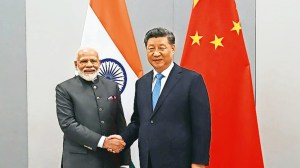Truths of the world force
Although spiritual knowledge covers a far greater proportion of the knowledge of the whole, it does not undermine or contradict the scient...

Although spiritual knowledge covers a far greater proportion of the knowledge of the whole, it does not undermine or contradict the scientific knowledge of the physical universe. The matter and the spirit stand at the two poles of the spectrum of the same being (Brahman) with various gradations of the physical and supraphysical in between. The methods of obtaining knowledge of spirit and matter may differ, but through either method one learns an aspect of the same being.
“The beginning of science is the examination of the truths of the world-force that underlie its apparent workings such as our senses represent them to be. The beginning of philosophy is the examination of the principles of things which the senses mistranslate to us. The beginning of spiritual knowledge is the refusal to accept the limitations of sense-life or to take the visible and sensible as anything more than phenomenon of the reality,” defines Sri Aurobindo in the synthesis of yoga.
The seer writes in òf40óThe Life Divine, “Not only in the one final conception, but in the great line of its general results, knowledge, by whatever path it is followed, tends to become one. Nothing can be more remarkable and suggestive than the extent to which modern science confirms in the domain of matter the conceptions and the very formulae of language which were arrived at, by a very different method, in the Vedanta… And these, on the other hand, often reveal their full significance, their richer contents, only when they are viewed in the new light shed by the discoveries of modern science. For instance, that Vedantic expression which describes things in the Cosmos as one seed arranged by the universal energy in multitudinous forms. Significant, especially, is the drive of science towards a Monism which is consistent with multiplicity, towards the Vedic idea of the one essence. For it will be evident that essential matter is a thing non-existent to the senses … and in fact the point isincreasingly reached where only an arbitrary distinction in thought divides form of substance from form of energy.”
When an ordinary individual with the load of ego, desires and falsehood, takes up the pursuit of spirit, he is prone to believe his imaginations, superstitions and perversions as the spiritual truths. “For the faculties that transcend the senses, by the very fact of their being immeshed in matter … are in danger of illuminating confusion rather than clarifying truth.” Sri Aurobindo reminds that, these perilous distortions and misleading imaginations in the past had actually “encrusted a real nucleus of truth with such an accretion of perverting superstitions and irrationalising dogmas that all advance in true knowledge was rendered impossible.”
He praises the materialistic and scientific view of physical world and itsprocesses. “And it is certainly the fact that the wider we extend and the surer we make our knowledge of the physical world, the wider and surer becomes our foundation for the higher knowledge, even for the highest, even for the Brahmavidya.”
Thus science is unquestionably a tool to know the physical aspect of Brahman but not the whole of it. The seer explains in letters to his disciples, “… Science could no longer claim to decide what was the real reality of things, that it had no means of deciding it and could only discover and describe the how and the process of the operations of material force in the physical front of things.” Science is not complete in itself and competent to discover the ultimate reality, and does require the support of supraphysical knowledge for its own perfection.
Photos




- 01
- 02
- 03
- 04
- 05


























